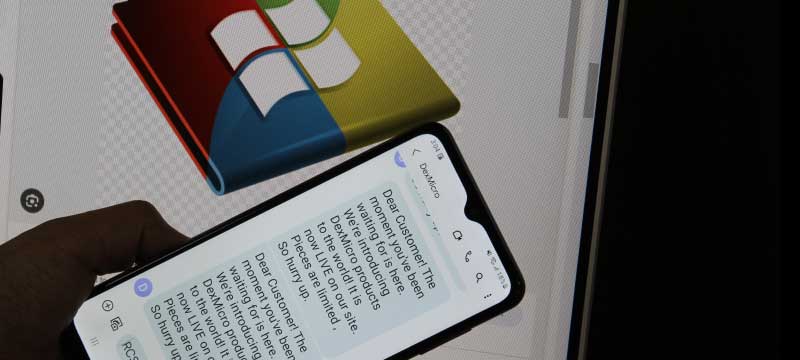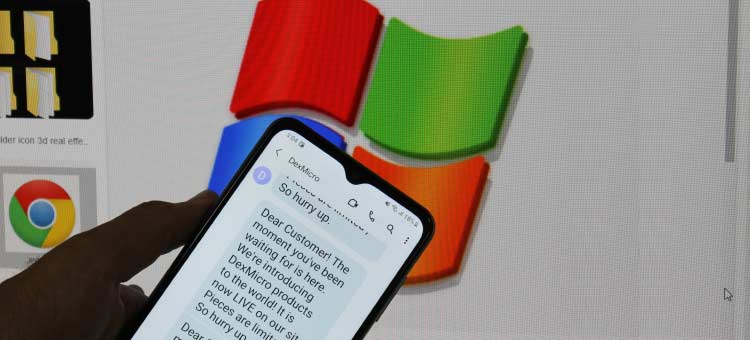Ensure the Privacy and Security of the SMS messages sent through Windows SMS Software
When using Windows SMS software to send messages to customers or clients, it is crucial to ensure the privacy and security of those messages. This is especially important if the messages contain sensitive information or are intended for a specific audience. Here are some ways to ensure the privacy and security of SMS messages sent through Windows SMS software:-
-
Choose a Secure SMS Provider:
When selecting a Windows SMS software provider, make sure to choose one that has a strong track record for security and privacy. Look for providers that use encryption to protect data and have a reputation for protecting customer data.
-
Use Two-Factor Authentication:
Two-factor authentication (2FA) adds an extra layer of security to your account by requiring a second factor, such as a code sent to your phone or email, in addition to your username and password. Enabling 2FA on your account can help prevent unauthorized access to your account and the SMS messages you send.
-
Use Strong Passwords:
Use strong passwords for your account and avoid using the same password for multiple accounts. A strong password should include a mix of letters, numbers, and symbols, and should be at least 8 characters long.
-
Secure your Device:
Make sure the device you are using to send SMS messages is secured with a strong password or PIN, and is protected by antivirus software. Keep your device’s operating system and applications up-to-date to ensure that security vulnerabilities are patched.
-
Encrypt SMS Messages:
Some Windows SMS software providers offer encryption features that can encrypt SMS messages before they are sent, ensuring that only the intended recipient can read the message.
-
Use a VPN:
A virtual private network (VPN) can provide an extra layer of security by encrypting your internet connection and masking your IP address. This can help prevent hackers from intercepting your SMS messages.
-
Limit Access to SMS Messages:
Only allow authorized personnel to access the Windows SMS software and the SMS messages sent through it. Limit access to the software to only those who need it to perform their job functions.
-
Monitor Usage:
Regularly monitor the SMS messages being sent through the Windows SMS software to ensure that they are appropriate and that there is no unauthorized use.
-
Comply with Regulations:
Make sure that the SMS messages you send comply with all applicable regulations, such as the General Data Protection Regulation (GDPR) or the Telephone Consumer Protection Act (TCPA).
By following these best practices, you can ensure that the SMS messages sent through your Windows SMS software are secure and private. Remember that security is an ongoing process, and you should regularly review and update your security practices to ensure that they remain effective over time.
Send Multimedia Messages (MMS) using Windows SMS Software
It is possible to send multimedia messages (MMS) using Windows SMS software. MMS messages allow you to send multimedia content such as images, videos, and audio files in addition to text messages. Key points to remember while sending MMS messages through Windows SMS software:-
-
Check MMS Message Size Limits:
MMS messages have a size limit, so make sure to check with your Windows SMS software provider to find out what the size limit is. If you try to send a message that exceeds the size limit, it may not be delivered or may be delivered in a degraded format.
-
Check Multimedia File Compatibility:
Different Windows SMS software providers support different file formats for multimedia files. Before sending an MMS message, make sure that the multimedia files you want to include are compatible with the Windows SMS software provider you are using.
-
Use High-Quality Multimedia Files:
When sending MMS messages, it is important to use high-quality multimedia files to ensure that the recipient can view and hear them properly. Low-quality multimedia files may be delivered in a degraded format, making them difficult or impossible to view or hear.
-
Consider the Recipient's Device:
Before sending an MMS message, consider the device that the recipient will be using to view it. Different devices may have different capabilities for displaying multimedia content, so it is important to choose files that are compatible with the recipient's device.
-
Get Permission to Send Multimedia Content:
If you plan to send MMS messages with multimedia content, make sure to obtain the recipient's permission before doing so. Some people may have limited data plans or may not want to receive multimedia content, so it is important to respect their preferences.
-
Comply with Regulations:
Make sure that the MMS (multimedia mesages) you send from your mobile device or computer system comply with all applicable regulations, such as the General Data Protection Regulation (GDPR) or the Telephone Consumer Protection Act (TCPA).
-
Choose a Windows SMS Software Provider that supports MMS:
Not all Windows SMS software providers support MMS messaging, so make sure to choose a provider that offers this feature.
Sending MMS messages through Windows SMS software can be a powerful way to engage with customers or clients. By following these best practices, you can ensure that your MMS messages are delivered properly and are well-received by the recipient.
Costs Associated with Windows SMS Software
The costs associated with Windows SMS software can vary depending on the provider, the features included, and the number of messages you plan to send. Different costs associated with Windows SMS software and the factors you should consider when choosing a provider:-
-
Monthly Subscription Fees
Most Windows SMS software providers charge a monthly subscription fee. This fee can range from $10 to $500 per month, depending on the provider and the features included. Some providers offer tiered pricing plans based on the number of messages you plan to send each month. For example, a provider may offer a basic plan for $10 per month that includes 100 messages and a premium plan for $50 per month that includes 1000 messages.
-
Additional Fees
Some Windows SMS software providers offer additional features, such as two-factor authentication, message scheduling, and message tracking. These features may be included in the monthly subscription fee or may incur additional fees. For example, a provider may charge an additional $50 per month for message tracking.
-
Pay-Per-Message Fees
In addition to monthly subscription fees, some providers also charge pay-per-message fees. This means that you will be charged a certain amount for each message you send. Pay-per-message fees can range from $0.01 to $0.10 per message, depending on the provider and the volume of messages you plan to send.
-
Setup Fees
Some providers may charge a one-time setup fee when you first sign up for their Windows SMS software. This fee can range from $50 to $500, depending on the provider and the level of customization required.
-
Support Fees
Some providers may charge additional fees for technical support. For example, a provider may charge an additional $50 per month for phone support or $100 per hour for custom development.
-
International Messaging Fees
If you plan to send SMS messages to international recipients, you may incur additional fees or charges. International messaging fees can range from $0.05 to $0.50 per message, depending on the provider and the destination country where the message was sent.
-
API Fees
If you plan to integrate your Windows SMS software with other systems or applications using an API, you may incur additional fees. API fees can range from $10 to $500 per month, depending on the provider and the level of customization required.
When choosing a Windows SMS software provider, it is important to consider the costs associated with the provider and the features included. It is also important to consider your messaging volume, as this will affect your monthly subscription fees and pay-per-message fees. Some providers offer free trials or demos, which can be a good way to test the software before committing to a subscription. Additionally, you should consider the level of technical support offered by the provider, as this can affect your overall costs and the success of your messaging campaigns.
Measure the Success of SMS Marketing Campaigns using Windows SMS Software
SMS marketing is a popular marketing strategy that businesses use to reach their customers directly on their mobile devices. SMS marketing campaigns can be an effective way to reach customers, promote products or services, and drive sales.
Windows SMS software is a software program that enables businesses to send and receive SMS messages from their desktop or laptop computer. This software allows businesses to send SMS messages to a large number of recipients quickly and easily. Windows SMS software can be used to create and send SMS marketing campaigns.

Measuring the success of SMS marketing campaigns is important to determine the effectiveness of the campaign and identify areas for improvement. There are several metrics that businesses can use to measure the success of SMS marketing campaigns using Windows SMS software.
-
Delivery Rate
Delivery rate is the percentage of SMS messages that were successfully delivered to recipients. Delivery rate can be affected by several factors, such as invalid phone numbers, mobile carrier restrictions, or technical issues. A high delivery rate indicates that the SMS marketing campaign was successful in reaching the target audience.
To measure the delivery rate of SMS marketing campaigns using Windows SMS software, businesses can compare the number of SMS messages sent to the number of SMS messages that were successfully delivered. Windows SMS software provides delivery reports that show the status of each SMS message sent.
-
Open Rate
Open rate is the percentage of SMS messages that were opened and read by recipients. Open rate can be affected by several factors, such as the timing of the SMS message, the relevance of the content, or the sender's reputation. A high open rate indicates that the SMS marketing campaign was successful in capturing the attention of the target audience.
To measure the open rate of SMS marketing campaigns using Windows SMS software, businesses can include a call-to-action (CTA) in the SMS message, such as a link to a website or a discount code. By tracking the number of clicks or redemptions, businesses can determine the open rate of the SMS message.
-
Conversion Rate
Conversion rate is the percentage of recipients who took the desired action after receiving the SMS message, such as making a purchase or filling out a form. Conversion rate can be affected by several factors, such as the relevance of the content, the ease of the action, or the value proposition. A high conversion rate indicates that the SMS marketing campaign was successful in driving sales or leads.
To measure the conversion rate of SMS marketing campaigns using Windows SMS software, businesses can track the number of conversions that resulted from the SMS message. For example, if the SMS message included a link to a product page, businesses can track the number of purchases made from that page.
-
ROI
The ROI (return on investment) is the ratio of the SMS marketing campaign's cost to the revenue generated by it. ROI can be affected by several factors, such as the conversion rate, the cost per SMS message, or the value of the product or service. A high ROI indicates that the SMS marketing campaign was successful in generating revenue that exceeds the cost of the campaign.
To measure the ROI of SMS marketing campaigns using Windows SMS software, businesses can calculate the revenue generated from the campaign and compare it to the cost of the campaign. Windows SMS software provides cost reports that show the cost of each SMS message sent.
-
Opt-out Rate
Opt-out rate is the percentage of recipients who opted out of receiving SMS messages after receiving the SMS marketing campaign. Opt-out rate can be affected by several factors, such as the frequency of the SMS messages, the relevance of the content, or the ease of opting out.
